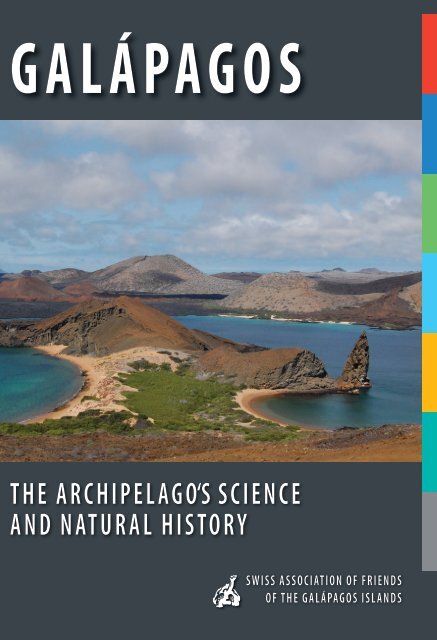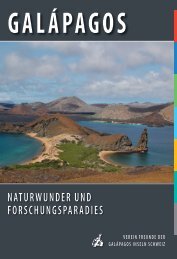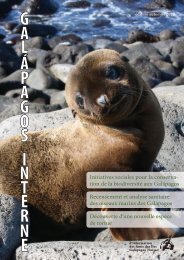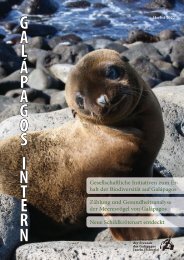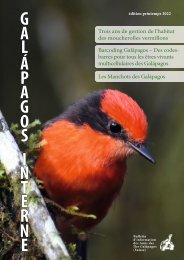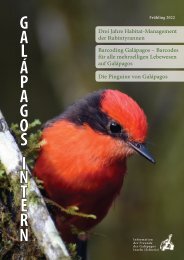You also want an ePaper? Increase the reach of your titles
YUMPU automatically turns print PDFs into web optimized ePapers that Google loves.
GALÁ PAGOS<br />
Islands of Fire<br />
THE ARCHIPELAGO‘S SCI<strong>EN</strong>CE<br />
AND NATURAL HISTORY<br />
SWISS ASSOCIATION OF FRI<strong>EN</strong>DS<br />
OF THE GALÁ PAGOS ISLANDS<br />
i
Islands of Fire<br />
SWISS ASSOCIATION<br />
OF FRI<strong>EN</strong>DS OF THE<br />
GALÁ PAGOS ISLANDS<br />
This travel guide was produced by<br />
the Swiss Association of Friends of<br />
the Galápagos Islands, a non-profit<br />
organization that supports projects<br />
for the preservation of Galápagos<br />
(www.galapagos-ch.org). The profits<br />
from sales of this book will help<br />
conservation and research projects<br />
throughout the Galápagos Islands.<br />
ii
Islands of Fire<br />
Islands of Fire<br />
BARR<strong>EN</strong> YET DIVERSE<br />
on Page 1<br />
Colonisation<br />
LUCK AND EXCEPTIONAL ABILITIES<br />
on Page 13<br />
Evolution<br />
A LITTLE WORLD WITHIN ITSELF<br />
on Page 35<br />
Fearless?<br />
TAME YET STRESSED<br />
on Page 57<br />
Test Tube Islands<br />
A SCI<strong>EN</strong>TIST‘S PARADISE<br />
on Page 71<br />
Conservation<br />
STUDY AND PROTECT<br />
on Page 95<br />
Species Guide<br />
ID<strong>EN</strong>TIFYING THE LOCALS<br />
on Page 113<br />
iii
Darwin<br />
Islands of Fire<br />
Wolf<br />
Pinta<br />
Marchena<br />
Ecuador Volcano<br />
Wolf Volcano<br />
Santiago<br />
Darwin Volcano<br />
Daphne Major<br />
Fernandina<br />
Alcedo Volcano<br />
Rábida<br />
Santa Cruz<br />
Baltra<br />
Isabela<br />
Cerro Azul Volcano<br />
Pinzón<br />
Sierra Negra Volcano<br />
Santo Tomás<br />
Puerto Villamil<br />
Bellavista<br />
Puerto Ayora<br />
Santa Fé<br />
N<br />
iv<br />
Human settlement<br />
100 km<br />
Puerto Velasco Ibarra<br />
Floreana<br />
Champion<br />
Gardner-por-<br />
Floreana
Panama<br />
Pacific Ocean<br />
Colombia<br />
Ecuador<br />
Peru<br />
Genovesa<br />
Seymour Norte<br />
San Cristóbal<br />
Puerto Baquerizo<br />
Moreno<br />
El Progreso<br />
Española<br />
Gardner-por-Española
GALÁPAGOS<br />
The Archipelago's Science<br />
and Natural History<br />
Swiss Association of<br />
Friends of the Galápagos Islands<br />
Lukas Keller, Ph.D.<br />
Marianne Haffner, Ph.D.<br />
Paquita Hoeck, Ph.D.<br />
Ursina Koller, M.Sc.<br />
Hendrik Hoeck, Ph.D.<br />
Zurich, Switzerland<br />
2018
SWISS ASSOCIATION OF<br />
FRI<strong>EN</strong>DS OF THE GALÁPAGOS ISLANDS<br />
Zurich<br />
Copyright 2018<br />
Lukas Keller, Marianne Haffner, Paquita Hoeck,<br />
Ursina Koller, Hendrik Hoeck<br />
English Translation: Lilian Dutoit, Anna-Sophie Wendel,<br />
Yves-Manuel Méan, Sabine Sonderegger, Aline Jenni,<br />
Anja Rosebrock, Mitchell Bornstein<br />
Layout and Design: Brian Maiorano<br />
ISBN 978-3-9525238-3-4<br />
All rights reserved. No part of this publication may be reproduced<br />
or transmitted in any form without the prior written permission of<br />
the Swiss Association of Friends of the Galápagos Islands.<br />
Printed in Austria: DGS GmbH, A-1220 Vienna
Dedicated to those, past and present,<br />
who have helped conserve these islands<br />
for the generations to come.
Islands of Fire<br />
BARR<strong>EN</strong> YET DIVERSE<br />
on Page 1<br />
Colonisation<br />
LUCK AND EXCEPTIONAL<br />
ABILITIES<br />
on Page 13<br />
Evolution<br />
A LITTLE WORLD<br />
WITHIN ITSELF<br />
on Page 35<br />
Fearless?<br />
TAME YET STRESSED<br />
on Page 57
Test Tube Islands<br />
A SCI<strong>EN</strong>TIST‘S PARADISE<br />
on Page 71<br />
Conservation<br />
STUDY AND PROTECT<br />
on Page 95<br />
Species Guide<br />
ID<strong>EN</strong>TIFYING THE LOCALS<br />
on Page 113<br />
Appendix<br />
BIBLIOGRAPHY<br />
ILLUSTRATION CREDITS<br />
ACKNOWLEDGEM<strong>EN</strong>TS<br />
INDEX<br />
ABOUT THE AUTHORS<br />
on Page 142<br />
on Page 144<br />
on Page 146<br />
on Page 146<br />
on Page 153
xii
Preface<br />
The Galápagos Islands evoke fantasies of paradise and are a dream destination<br />
of many a traveller. The islands’ unique and bizarre creatures such<br />
as marine iguanas, flightless cormorants, giant tortoises, or finches with<br />
bills of all shapes and sizes have made the archipelago world-famous.<br />
Charles Darwin was fascinated with the forms of life he explored there<br />
during his visit in 1835. These observations would later contribute substantially<br />
to the development of his theory of evolution. To this day, these<br />
unique islands are considered a natural laboratory to study the processes<br />
of evolution and are a dream research site for most biologists.<br />
But the islands have witnessed many changes since Darwin’s visit.<br />
Whereas a few decades ago it was mainly naturalists who visited and very<br />
few people actually lived on the islands, tourism and the resident human<br />
population have grown exponentially since the 1990s. The native animals<br />
and plants have struggled with the negative effects of introduced species<br />
and other anthropogenic changes to the formerly isolated ecosystem.<br />
Thanks to elaborate conservation measures some of the negative effects<br />
have been mitigated, but many challenges remain if we are to preserve this<br />
fascinating ecosystem.<br />
While there is no such thing as a zero-impact trip to the Galápagos,<br />
every individual travelling there can contribute to the preservation of this<br />
fantastic site: follow the National Park guidelines, choose your form of<br />
travel wisely, inform yourself about the islands' uniqueness, and support<br />
conservation and education projects that benefit the islands. With joint<br />
efforts and a global recognition of the area's importance, the wonderful<br />
Galápagos creatures may be enjoyed by many future generations.<br />
About this book<br />
Written by scientists with long-standing professional and personal connections<br />
to Galápagos, this book provides a comprehensive overview of<br />
the natural history and ecology of the Galápagos Islands. We investigate<br />
the peculiar evolution that happened on these islands and how scientific<br />
activities shape our understanding of this place and also help us preserve<br />
it.<br />
Using examples of specific species, this book showcases key evolutionary<br />
processes and encourages the reader to think about ecological or behavioural<br />
contexts when observing animals or plants in Galápagos. The<br />
book uses abundant photographs and illustrations to give the reader a<br />
visual tour through the different topics. It also contains a wildlife guide<br />
showing some of the animal and plant species that the visitor is most likely<br />
to encounter.<br />
This book is a complement to the site-specific information that visitors<br />
on a guided tour will receive from their National Parks guide. It also<br />
makes for either a great pre-trip read, or an entire virtual tour for the<br />
armchair traveller.<br />
xiii
Islands of Fire<br />
xiv
Islands of Fire<br />
BARR<strong>EN</strong> YET DIVERSE<br />
Islands of Fire<br />
V<br />
olcanic eruptions created the Galápagos Islands, and these eruptions<br />
continue to shape the islands even today. Only a relatively <strong>short</strong> time<br />
ago, new habitats for plants and animals emerged—in complete isolation—in<br />
the middle of the ocean. The islands are located at the equator<br />
in the tropics, but the climate is subject to significant seasonal variations,<br />
because warm and cold ocean currents meet here and interact with each<br />
other. Above all, the region is extremely arid. That's why plants adapted to<br />
dry climates predominate. However, the higher an island, the greater the<br />
variety of plant communities.<br />
1
Islands of Fire<br />
Volcanic Islands<br />
The Galápagos Archipelago is completely isolated in the middle of the<br />
Pacific Ocean, about 960 km off the west coast of South America. It<br />
consists of 19 main islands (larger than 1 sq. km) and many smaller islands,<br />
as well as numerous islets and rocks. They are spread over more<br />
than 120,000 sq. km of ocean and consist of a total land surface of about<br />
8,000 sq. km.<br />
The Galápagos Islands are of volcanic origin. On Isabela and Fernandina,<br />
some volcanoes are still active. The westernmost island, Fernandina, is<br />
the centre of volcanic activity. Below it, a magma chamber of molten rock<br />
is located deep down in the earth’s interior. This hotspot is the origin of<br />
the Galápagos Islands.<br />
Young islands in motion<br />
The Galápagos Islands are located on the Nazca Plate, which moves towards<br />
South America at a rate of about 6 cm per year. While the islands<br />
move, the hotspot—the origin of the volcanic islands—stays in the same<br />
place.<br />
The islands are between 35,000 and 4 million years old. It is during this<br />
period that most evolution occurred and new species developed.<br />
There are also sunken islands up to 2,500 m below sea level that are<br />
probably about 5 to 14 million years old. There is evidence suggesting that<br />
some of today’s species have ancestors that go back more than 3 to 4 million<br />
years. Therefore, the most likely scenario is that evolution already<br />
occurred on these islands while they were still above sea level.<br />
Evolution of an Island Chain<br />
Nazca<br />
Plate<br />
Hot magma presses<br />
into the fissures<br />
of the Nazca<br />
Plate and creates<br />
chambers close to<br />
the surface.<br />
2<br />
The heat of the<br />
magma melts the<br />
earth’s surface<br />
crust, causing a<br />
volcanic eruption on<br />
the ocean floor.<br />
With every eruption, new layers of lava<br />
increase the size of the volcano until it breaks<br />
the ocean surface to form a new island.
Islands of Fire<br />
The crust and the upper part of the earth's mantle (lithosphere) consist of plates: seven<br />
major plates and many small ones, which are more or less mobile. The largest plates carry<br />
continents such as South America, Africa or Eurasia. Smaller plates can carry islands, such<br />
as the Galápagos Islands on the Nazca Plate.<br />
The temperatures below the plates are so high that they partially melt the rock. This<br />
subter ranean molten mass is called magma. As soon as it is expelled to the surface of the<br />
earth, it is called lava.<br />
Nazca<br />
Plate<br />
HS<br />
HS<br />
The Nazca Plate<br />
moves above the<br />
fixed hotspot<br />
(HS), the magma<br />
chamber.<br />
On its journey atop the<br />
Nazca Plate, the volcano<br />
gradually loses its connection<br />
to the magma<br />
chamber and becomes<br />
extinct.<br />
The magma chamber<br />
creates a new volcano.<br />
The old island is eroded<br />
mainly by wind and<br />
weather, causing it to<br />
decrease in size until<br />
it disappears from the<br />
ocean surface.<br />
3
Islands of Fire<br />
Ages of Islands and Years of Volcanic Eruptions<br />
Formed<br />
< 0.5 million<br />
years ago<br />
approx.<br />
1150<br />
2018<br />
2015<br />
1813<br />
1993<br />
1928<br />
1991<br />
Formed 1–2.5<br />
million years ago<br />
1906<br />
Santiago<br />
formed<br />
> 2.5 million<br />
years ago<br />
hotspot with magma chamber<br />
active volcano (last eruption)<br />
sunken islands<br />
movement of Nazca plate<br />
Isabela<br />
2018<br />
2008<br />
Santa<br />
Cruz<br />
San Cristóbal<br />
Floreana<br />
Española<br />
N<br />
The Nazca Plate moves southeast over the hotspot, the origin of the volcanic islands. The oldest<br />
islands with the lowest elevations can be found in the southeastern part of the archipelago,<br />
whereas the youngest islands with the largest volcanoes are located in the northwest. On the islands<br />
of Isabela and Fernandina, there are still some active volcanoes. The last volcanic eruptions<br />
took place in 2008 (Cerro Azul Volcano on Isabela), 2009 (on Fernandina), 2015 (Wolf Volcano on<br />
Isabela), and 2018 (Sierra Negra Volcano on Isabela and La Cumbre Volcano on Fernandina).<br />
4
Islands of Fire<br />
In 1968, the crater floor of La Cumbre Volcano on the island of Fernandina sank by 350 m. In<br />
1988, a lake started to form in the northern part of the crater. (dotted line: level of the crater floor<br />
before 1968)<br />
“... as far as the eye could reach we saw nothing but rough fields of lava, that seemed to<br />
have hardened while the force of the wind had been rippling its liquid surface [...] About<br />
half way down the steep south east side of the Island, a volcano burns day and night;<br />
and near the beach a crater was pouring forth streams of lava, which on reaching the sea<br />
caused it to bubble in an extraordinary manner.“ This is how Captain Lord George Anson<br />
Byron described a volcanic eruption in 1825 as he lay at anchor off Fernandina during his<br />
long journey to the Sandwich Islands (Hawaiian Islands).<br />
5
Islands of Fire<br />
Climate<br />
Atypical: tropical islands with a dry climate<br />
The dry climate on the Galápagos Islands is very atypical of the tropics.<br />
Equally atypical is the pronounced seasonability, with a warm season between<br />
January and May with frequent, heavy rains; and a very dry season<br />
between June and December with only little precipitation in the island<br />
lowlands. This anomaly can be explained by the ocean currents that meet<br />
and interact here in the Pacific Ocean. Two currents carry cold water: the<br />
Peru Current (Humboldt Current) from the Antarctic and the Equatorial<br />
Undercurrent (Cromwell Current) from the deep sea. Together they are<br />
responsible for the cool, dry season. The Panama Current brings warm<br />
tropical water from Central America and affects the warm season. The<br />
little precipitation that does occur during the dry season is a light drizzle<br />
called garúa, which often stops around noon.<br />
North Equatorial Countercurrent<br />
Panama<br />
Current<br />
Equatorial<br />
Undercurrent<br />
South Equatorial Current<br />
Ecuador<br />
Humboldt Current<br />
Peru Cu rent<br />
“El Niño”: both a blessing and a curse<br />
At irregular intervals about every 3 to 6 years, significant changes in ocean<br />
current conditions lead to a much warmer and rainier season called “El<br />
Niño”. The name is Spanish for the Infant Jesus, and is used because the<br />
phenomenon is strongest at Christmas time. El Niño is both a blessing and<br />
a curse: in the interior of the island, it leads to times of plenty, but it has<br />
severe consequences for the sea and the coastal areas. Sea birds suffer<br />
from lack of food (fish) and the high surf may flood their breeding sites as<br />
well as the nesting grounds of sea turtles and marine iguanas. In 1982 and<br />
1983, the water temperature became so warm that it caused the death of<br />
most of the green algae on which marine iguanas mainly feed. As a result,<br />
the populations of this species declined dramatically.<br />
There are also cold and dry seasons, which are called “La Niña”.<br />
6
Islands of Fire<br />
The difference between a wet (El Niño) and dry year on Daphne Major.<br />
Greater plant diversity on high islands<br />
Most of the islands are not high and have a very dry climate. Only plants<br />
that are highly adapted to drought can be found on such islands. However,<br />
on high islands, there are up to five different zones, each with unique<br />
plant communities that differ in the amount of water they need.<br />
In higher zones, more rain falls, supporting plants that need more<br />
moisture. The reason for the higher rainfall is that the air is cooler, causing<br />
the moisture in the clouds to condense and fall as rain. However, on<br />
very high islands another dry zone exists above the clouds.<br />
The various zones do not run parallel to each other around the islands<br />
and they are not the same in all areas. For example, the dry zones in<br />
7
About the Authors<br />
Lukas Keller is a professor in evolutionary<br />
biology and director of the Zoological Museum<br />
at the University of Zürich in Switzerland. He<br />
studied evolution and inbreeding in Darwin’s<br />
finches and mockingbirds for many years, during<br />
which he spent many months on remote<br />
islands in the Galápagos. In 2014 he became<br />
president of the Swiss Association of Friends of<br />
the Galápagos Islands (SAFGI)<br />
Appendix<br />
Marianne Haffner taught biology and performed<br />
research at the University of Zürich for<br />
many years before she became manager of the<br />
university’s Zoological Museum. In 2012 Marianne<br />
was heavily involved in the development<br />
of a Galápagos exhibit designed at the museum.<br />
Paquita Hoeck spent the first years of her<br />
life on the Galápagos when her father was director<br />
at the Charles Darwin Research Station.<br />
As a PhD student in biology, she returned to<br />
Galápagos to investigate the genetic composition<br />
of mockingbirds on different islands.<br />
Paquita runs the office of the SAFGI.<br />
Ursina Koller is a teacher and biologist by<br />
training, and works as head of education at the<br />
Zoological Museum of the University of Zürich.<br />
Her involvement in an exhibit about Galápagos<br />
and a trip to the islands aroused her passion for<br />
this unique place and resulted in her becoming<br />
a board member of the SAFGI.<br />
Hendrik Hoeck is a biologist and former director<br />
of the Charles Darwin Research Station<br />
on Santa Cruz Island. He is the founder of the<br />
SAFGI and has been involved in conservation<br />
efforts in Galápagos for over 30 years. As a tour<br />
guide, he led countless groups to the islands.<br />
153
Pinta (Abingdon)<br />
59 km 2 , origin of Lonesome<br />
George, no visitor site<br />
Isabela (Albermarle)<br />
ca. 4700 km 2 , six volcanoes, inhabited<br />
Mangroves, scalesia, candelabra cactus<br />
Cormorants, giant tortoises, land iguanas<br />
Santiago (James)<br />
577 km 2 , salt-lake crater<br />
Pahoehoe lava structures<br />
Mangroves, muyuyu, palo santo<br />
Fur seals, hawks, Sally Lightfoot crab<br />
Fernandina (Narborough)<br />
638 km 2 , youngest island, most active volcano<br />
Lava cactus, mangroves, saltbush<br />
Cormorants, penguins, marine iguanas<br />
N<br />
Human settlement<br />
Rábida (Jervis)<br />
5 km 2 red sand beach<br />
Palo santo, opuntia cactus, croton, black mangroves<br />
Sea lions, Darwin’s finches, flamingos, white-cheeked pintails<br />
Pinzón (Duncan)<br />
18 km 2 , no visitor site<br />
50 km
Appendix<br />
Marchena (Bindloe)<br />
130 km 2 , no visitor site<br />
Genovesa (Tower)<br />
14 km 2 , old shield volcano<br />
Palo santo, croton, muyuyu<br />
Swallow-tailed gulls, red-footed boobies, <strong>short</strong>-eared owl<br />
Bartolomé (Bartholomew)<br />
1.2 km 2 , dramatic volcanic formations, Pinnacle Rock<br />
Mangroves, grey matplant, lava cactus<br />
Penguins, reef sharks, rays<br />
Seymour Norte (North Seymour)<br />
1.9 km 2 , lava plateau<br />
Palo santo trees, parkinsonia, opuntia cactus, croton<br />
Boobies, frigate birds, land and marine iguanas<br />
Baltra (South Seymour)<br />
26 km 2 , airport<br />
Reintroduced land iguanas, Darwin’s finches<br />
Daphne Mayor (Daphne Major)<br />
0.3 km 2 , no visitor site<br />
Well-known for Darwin‘s finch studies<br />
Plaza Sur (-)<br />
0.13 km2, lava plateau<br />
Sesuvium, Galápagos carpetweed, opuntia cactus<br />
Land iguanas, red-billed tropicbirds, swallow-tailed gulls<br />
Santa Cruz (Indefatigable)<br />
986 km 2 , lava tunnels<br />
Mangroves, scalesia, opuntia cactus<br />
Giant tortoises, flycatchers, Darwin’s finches<br />
Floreana (Charles, Santa María)<br />
173 km 2 , first island colonized by humans,<br />
Post Office Bay<br />
Scalesia, palo santo, croton<br />
Marine iguanas, Darwin’s finches, flamingos<br />
Santa Fé (Barrington)<br />
24 km 2, Tree opuntia, palo santo, saltbush<br />
Land iguanas, sea lions, rice rats<br />
San Cristóbal (Chatham)<br />
557 km 2 , capital of Galápagos, inhabited<br />
Mangroves, candelabra cacti, muyuyo<br />
Giant tortoises, frigatebirds, sea lions<br />
Española (Hood)<br />
60 km 2 , old, flat island, blowhole<br />
Parkinsonia, mesquite, saltbush<br />
Sea lions, Galápagos albatross, boobies, mockingb<br />
155
Appendix<br />
SWISS ASSOCIATION<br />
OF FRI<strong>EN</strong>DS OF THE<br />
GALÁ PAGOS ISLANDS<br />
Support science and conservation<br />
in Galápagos.<br />
Become a member:<br />
www.galapagos-ch.org<br />
156
Appendix<br />
UNIQUE AND BIZARRE PARADISE<br />
The Galápagos Islands are a dream destination unlike any other<br />
spot on earth. This book showcases the evolution and peculiarities<br />
of this unique place, from the formation of the volcanic islands to its<br />
colonization by plants, animals, and—more recently—humans.<br />
Why are reptiles the largest animals on land and why are there so<br />
few mammals? Why are so many Galápagos species found nowhere<br />
else? And why don’t blue-footed boobies or land iguanas flee when we<br />
approach them? The book answers these and many more questions.<br />
Written by scientists who have lived and worked in the Galápagos,<br />
this book shows how the islands have shaped our understanding<br />
of evolution. With more than 330 full-color photographs and<br />
illustrations, the reader is taken on a visual tour while learning<br />
about the latest science and research activities that contribute to the<br />
conservation of the islands. Plus, an illustrated guide identifies more<br />
than 125 commonly seen species of animals and plants.<br />
157


